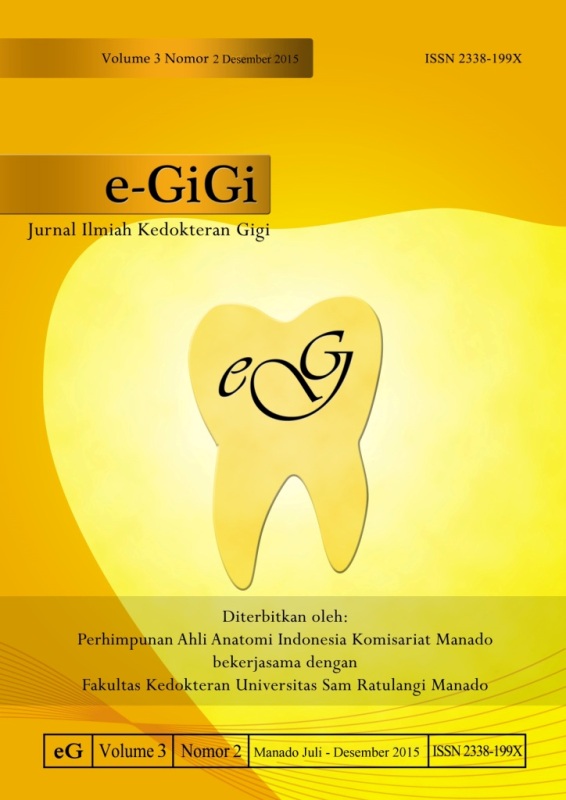UJI MINIMUM INHIBITORY CONCENTRATION (MIC) EKSTRAK RUMPUT LAUT (Eucheuma cottonii) SEBAGAI ANTIBAKTERI TERHADAP Streptococcus mutans
DOI:
https://doi.org/10.35790/eg.3.2.2015.9630Abstract
Abstract: Dental caries is an oral cavity disease which becomes a health problem in Indonesia. Bacteria that play some important role in caries formation are Streptococcus mutans. One of the nature material that can be used to restrain Streptococcus mutans is seaweed Eucheuma cottonii. This study aimed to determine the Minimum Inhibitory Concentration (MIC) of seaweed Eucheuma cottonii extract against Streptococcus mutans. This was an experimental laboratory study with a post test only control group design. MIC test was done by serial dilution, turbidimetry, and spectrophotometry methods, as well as bactericidal test using aa calibration method. Eucheuma cottonii were taken from the sea around Naen island and then were extracted with maceration method using ethanol 96%. The results showed that the MIC of Echeuma cottonii extract was in the concentration of 6.25% against Streptococcus mutans. Growth inhibition of Streptococcus mutans was significant in the concentration of 6.25%, 12.5%, 25%, 50%, and 100%. MIC of Eucheuma cottonii extract was 6.25% but the MBC or bactericidal effect was not found.The higher concentration of Eucheuma cottonii used, the greater ability to inhibit the growth of Streptococcus mutans. Conclusion: Seaweed Echeuma cottonii extract has bacteriostatic abilities but do not have bactericide abilities to against Streptococcus mutans.
Keywords: streptococcus mutans, mic, eucheuma cottonii, alternative medicine, coastal communities
Abstrak: Karies gigi merupakan penyakit rongga mulut yang paling banyak diderita masyarakat dan menjadi salah satu masalah kesehatan di Indonesia. Bakteri yang paling berperan dalam pembentukan karies adalah Streptococcus mutans. Cara alternatif untuk menanggulangi Streptococcus mutans adalah dengan menggunakan bahan alami yaitu rumput laut (Eucheuma cottonii).Tujuan penelitian ini adalah untuk mengetahui Minimum Inhibitory Concentration (MIC) rumput laut (Eucheuma cottonii) terhadap Streptococcus mutans. Penelitian ini merupakan penelitian eksperimental laboratorium menggunakan desain post-test only control group design. Uji MIC dilakukan dengan metode serial dilusi, turbidimetri dan spektrofotometri, serta uji kalibrasi untuk uji sifat bakteriosid. Sampel diambil dari perairan pulau Naen kemudian diekstraksi dengan metode maserasi menggunakan pelarut etanol 96%. Hasil penelitian menunjukkan bahwa MIC ekstrak rumput laut (Eucheuma cottonii) pada konsentrasi 6.25% terhadap Streptococcus mutans. Hasil analisis dan pengolahan data menunjukkan daya hambat ekstrak rumput laut (Eucheuma cottonii) terhadap pertumbuhan Streptococcus mutans yang paling signifikan ialah konsentrasi 6,25%, 12,5%, 25%, 50%, dan 100%. MIC ekstrak rumput laut (Eucheuma cottonii) 6,25% sedangkan MBC atau sifat bakteriosid tidak ditemukan. Semakin tinggi konsentrasi ekstrak rumput laut (Eucheuma cottonii) yang digunakan, maka semakin besar kemampuan menghambat pertumbuhan Streptococcus mutans. Simpulan: Ekstrak rumput laut (Eucheuma cottonii) memiliki sifat bakteriostatik namun tidak memiliki sifat bakteriosid terhadap Streptococcus mutans.
Kata kunci: streptococcus mutans, mic, eucheuma cottonii, pengobatan alternatif, masyarakat pesisir pantai
Downloads
How to Cite
Issue
Section
License
COPYRIGHT
Authors who publish with this journal agree to the following terms:
Authors hold their copyright and grant this journal the privilege of first publication, with the work simultaneously licensed under a Creative Commons Attribution License that permits others to impart the work with an acknowledgment of the work's origin and initial publication by this journal.
Authors can enter into separate or additional contractual arrangements for the non-exclusive distribution of the journal's published version of the work (for example, post it to an institutional repository or publish it in a book), with an acknowledgment of its underlying publication in this journal.
Authors are permitted and encouraged to post their work online (for example, in institutional repositories or on their website) as it can lead to productive exchanges, as well as earlier and greater citation of the published work (See The Effect of Open Access).






